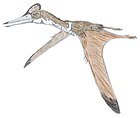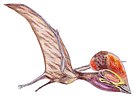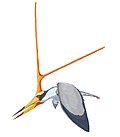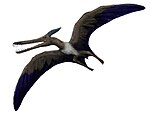Nipponopterus
| Nipponopterus Temporal range: Late Cretaceous,
| |
|---|---|

| |
| Skeletal reconstruction | |
| Scientific classification | |
| Domain: | Eukaryota |
| Kingdom: | Animalia |
| Phylum: | Chordata |
| Order: | †Pterosauria |
| Suborder: | †Pterodactyloidea |
| Family: | †Azhdarchidae |
| Subfamily: | †Quetzalcoatlinae |
| Genus: | †Nipponopterus Zhou et al., 2024 |
| Species: | †N. mifunensis
|
| Binomial name | |
| †Nipponopterus mifunensis Zhou et al., 2024
| |
Nipponopterus (meaning "Nippon wing") is an extinct genus of azhdarchid pterosaurs from the Late Cretaceous Mifune Group of Japan. The genus contains a single species, N. mifunensis, known from a partial neck vertebra. Nipponopterus represents the first pterosaur to be named from Japan.
Discovery and naming
[edit]The Nipponopterus holotype specimen, MDM 349, was discovered in sediments of the "Upper Formation" of the Mifune Group ('Locality 1018') in rock outcrops near Amagimi Dam in Mifune Town, Kumamoto Prefecture in Kyūshū, Japan. The specimen consists of the posterior end of the sixth cervical vertebra. The specimen was first described in 2000 as belonging to an indeterminate azhdarchid. The limited understanding of the clade at that time precluded more detailed analyses.[1] While early reviews interpreted the cervical vertebra as the fourth[2] or fifth,[3] the most recent analysis suggests it can confidently be regarded as the sixth.[4]
In 2024, Zhou et al. described Nipponopterus mifunensis as a new genus and species of azhdarchid pterosaurs based on these fossil remains. The generic name, Nipponopterus, combines "Nippon"—the Japanese name for the country—with "pterus", derived from the Ancient Greek word ptéron, meaning "wing". The specific name, mifunensis, references the type locality in the Mifune Group in Mifune Town. Nipponopterus is the first pterosaur named from Japan.[4]
A wing phalanx and metacarpal belonging to indeterminate azhdarchid pterosaurs are also known from this formation, but have not been referred to Nipponopterus.[4]
Description
[edit]
The Nipponopterus holotype is morphologically comparable to a similarly fragmentary unnamed pterosaur specimen from Mongolia, nicknamed the "Burkhant azhdarchid".[5] Measurements of the Nipponopterus material indicates that it is 82% the size of the Burkhant specimen. However, the former likely belongs to a subadult individual, so was not fully grown. As such, Zhou et al. (2024) estimate that both pterosaurs would have had similar wingspans, at around 3–3.5 metres (9.8–11.5 ft).[4]
Classification
[edit]
In their phylogenetic analysis using the dataset of Pêgas (2024),[6] Zhou et al. (2024) recovered Nipponopterus as a member of the azhdarchid clade Quetzalcoatlinae, as the sister taxon to the Burkhant azhdarchid. Their results are displayed in the cladogram below:[4]
| Azhdarchomorpha |
| ||||||||||||||||||||||||||||||||||||||||||||||||||||||||||||||||||||||||||||||||||||||||||
References
[edit]- ^ Ikegami, Naoki; Kellner, Alexander W. A.; Tomida, Yukimitsu (2000). "The presence of an azhdarchid pterosaur in the Cretaceous of Japan". Paleontological Research. 4 (3): 165–170. doi:10.2517/prpsj.4.165 (inactive 2024-11-16).
{{cite journal}}: CS1 maint: DOI inactive as of November 2024 (link) - ^ Averianov, Alexander (2014-08-11). "Review of taxonomy, geographic distribution, and paleoenvironments of Azhdarchidae (Pterosauria)". ZooKeys (432): 1–107. doi:10.3897/zookeys.432.7913. ISSN 1313-2970. PMC 4141157. PMID 25152671.
- ^ Andres, B.; Langston, W. Jr. (2021). "Morphology and taxonomy of Quetzalcoatlus Lawson 1975 (Pterodactyloidea: Azhdarchoidea)". Journal of Vertebrate Paleontology. 41 (sup1): 142. Bibcode:2021JVPal..41S..46A. doi:10.1080/02724634.2021.1907587. ISSN 0272-4634. S2CID 245125409.
- ^ a b c d e Zhou, Xuanyu; Ikegami, Naoki; Pêgas, Rodrigo V.; Yoshinaga, Toru; Sato, Takahiro; Mukunoki, Toshifumi; Otani, Jun; Kobayashi, Yoshitsugu (2024-11-16). "Reassessment of an azhdarchid pterosaur specimen from the Mifune Group, Upper Cretaceous of Japan". Cretaceous Research: 106046. doi:10.1016/j.cretres.2024.106046. ISSN 0195-6671.
- ^ a b c Watabe, Mahito; Tsuihiji, Takanobu; Suzuki, Shigeru; Tsogtbaatar, Khishigjav (2009). "The First Discovery of Pterosaurs from the Upper Cretaceous of Mongolia" (PDF). Acta Palaeontologica Polonica. 54 (2): 231–242. doi:10.4202/app.2006.0068. ISSN 0567-7920.
- ^ Pêgas, Rodrigo V. (2024-06-10). "A taxonomic note on the tapejarid pterosaurs from the Pterosaur Graveyard site (Caiuá Group, ?Early Cretaceous of Southern Brazil): evidence for the presence of two species". Historical Biology: 1–22. doi:10.1080/08912963.2024.2355664. ISSN 0891-2963.
- ^ Vremir, Mátyás; Witton, Mark; Naish, Darren; Dyke, Gareth; Brusatte, Stephen L.; Norell, Mark; Totoianu, Radu (2015-03-17). "A Medium-Sized Robust-Necked Azhdarchid Pterosaur (Pterodactyloidea: Azhdarchidae) from the Maastrichtian of Pui (Haţeg Basin, Transylvania, Romania)". American Museum Novitates (3827): 1–16. doi:10.1206/3827.1. ISSN 0003-0082.













